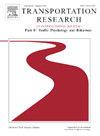利用自然驾驶数据验证驾驶模拟中的风险行为
IF 3.5
2区 工程技术
Q1 PSYCHOLOGY, APPLIED
Transportation Research Part F-Traffic Psychology and Behaviour
Pub Date : 2024-10-15
DOI:10.1016/j.trf.2024.09.026
引用次数: 0
摘要
驾驶模拟没有实际事故风险,可以安全地研究关键的驾驶情况,但同时也降低了驾驶员的风险意识,可能导致不切实际的驾驶行为。出于道德原因,这方面的验证研究并不多见,因此目前很难评估这一问题的严重程度。本研究利用自然驾驶数据填补了这一空白。本研究从自然数据中提取了德国高速公路上的四种关键切入情况,并在有 58 名参与者参加的驾驶模拟器研究中进行了复制。研究收集了驾驶员主观临界度的现场自我评分、基于视频的事后评分(来自驾驶员和客观观察者)以及临场评分,作为对驾驶员行为的补充。虽然驾驶员在模拟器和现场的反应在绝对值上并不等同,但模拟器和真实世界中的驾驶员都通过制动反应表现出了避免事故的行为,这表明了相对有效性。没有发现存在感对更谨慎的驾驶行为有明显的中介作用。这项研究表明,驾驶员在模拟器中表现出了避免事故的行为,并倾向于对模拟器中的危险做出与真实情况类似的反应,但对绝对数值的解释必须谨慎。本文章由计算机程序翻译,如有差异,请以英文原文为准。
Validating risk behavior in driving simulation using naturalistic driving data
The absence of physical accident risk in driving simulation, which allows for safely studying critical driving situations, also reduces the driver's risk perception, which may result in unrealistic driver behavior. Validation studies in this context are rare for ethical reasons, making it difficult to assess the extent of this issue at present. The present study addresses this gap by utilizing naturalistic driving data. Four critical cut-in situations on German highways were extracted from naturalistic data and replicated in a driving simulator study with N = 58 participants. Both in-situ self-ratings on subjective criticality and post-hoc video-based ratings (from the driver and objective observers), as well as presence ratings, were collected to supplement driver behavior. Although driver reactions in the simulator and the field were not equivalent in absolute terms, drivers in both the simulation and the real world exhibited accident-avoidance behavior through braking reactions, indicating relative validity. No clear mediating role of the sense of presence towards a more careful driver behavior was found. This work shows that drivers exhibit accident-avoiding behavior in the simulator and tend to react to hazards in the simulator similarly as they would in a real situation, while absolute numerical values should only be interpreted with caution.
求助全文
通过发布文献求助,成功后即可免费获取论文全文。
去求助
来源期刊
CiteScore
7.60
自引率
14.60%
发文量
239
审稿时长
71 days
期刊介绍:
Transportation Research Part F: Traffic Psychology and Behaviour focuses on the behavioural and psychological aspects of traffic and transport. The aim of the journal is to enhance theory development, improve the quality of empirical studies and to stimulate the application of research findings in practice. TRF provides a focus and a means of communication for the considerable amount of research activities that are now being carried out in this field. The journal provides a forum for transportation researchers, psychologists, ergonomists, engineers and policy-makers with an interest in traffic and transport psychology.

 求助内容:
求助内容: 应助结果提醒方式:
应助结果提醒方式:


